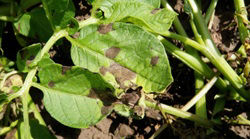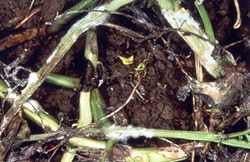Precise Practices to Protect Your Potatoes from Early Blight and White Mold
March 26, 2025

Growing high-quality potatoes can feel like it requires the ultimate balance and precision with little room for error. Too much nitrogen late in the growing season reduces crop yields but not enough early on suppresses tuber growth. The same irrigation practices that promote healthy canopy growth to support tuber bulking – and increase yield – cause moist conditions that can lead to serious fungal disease pressures in potatoes.
As a potato grower, you are focused on high quality and high yield. To protect your crop against white mold, early blight and other diseases, trust what the experts trust – Luna® PRO.
Disease Threats to Tubers

Early blight first appears as small, irregular brown spots on mature potato leaves.
Early blight is a common disease found in most areas where potatoes are grown. According to the University of Idaho Extension, the disease typically develops, in their geography, on mature foliage. Early blight thrives in wet conditions and first shows up as small, dark-brown circles on lower and older leaves. During the important early- and mid-bulking periods, severe foliar infections can lead to smaller potatoes, lower dry matter content and yield loss.
Moist conditions and excessive irrigation can also lead to another important disease in potatoes – white mold, or Sclerotinia stem rot. According to the University of Idaho Extension, white mold first appears as water-soaked lesions covered with a white, cottony growth that can spread quickly to other stems and leaves. In severe cases, plants die from the disease. White mold also overwinters from one growing season to the next, potentially resulting in ongoing losses when the field is replanted to potato.
“Because of our growing conditions and our vine growth that we get in the Pacific Northwest, white mold has potentially the most impact,” says Nevada Smith, potato crop manager for Crop Science. “It can damage the entire plant.”
Treat Early Blight and White Mold

White mold symptoms include small white spots on leaves consisting of a cottony white growth that can spread rapidly.
Both early blight and white mold can be a detriment to overall plant health, and treatment can help protect crop yield and quality. Growers need to optimize their time in the field and investment in protecting their potato crop, however few fungicide treatment options exist that address both concerns.
Crop rotation is one effective cultural control that can protect potato fields from early blight and white mold. Both diseases can overwinter and survive in the soil for years if infected plant debris remains in the field. For effective blight treatment, the University of Idaho Extension recommends rotating crops grown in a particular field from season to season.
Corn and small grains, for example, are non-host crops that interrupt the life cycle of the fungi. Another recommended practice is timing irrigation for drier, warmer weather earlier in the day, allowing the crop to dry before nightfall.
In addition to cultural practices, foliar fungicides can help eradicate both diseases from the field. Fungicides should be applied preventatively or at the first sign of early blight symptoms. In severe cases of white mold, apply fungicides preventatively or at initial full bloom.
Luna PRO fungicide from Crop Science provides a systemic solution for exceptional, extended protection against early blight, white mold and other key potato diseases. As Luna PRO belongs to a unique chemical class different from all other SDHI fungicides, Luna PRO effective early blight fungicide solution for even the most difficult fields.
In recent years, challenges with SDHI-resistant strains of early blight have emerged. Although Luna PRO belongs to the SDHI class of compounds, it still controls these same resistant strains, and it provides an effective solution for even the most difficult fields.
As potato crops get closer to maturity and harvest, vigilant monitoring and management of early blight, white mold and other key potato pests can help lead to market-ready, high-quality potatoes.